#Jataka tales
Text

Buddha to his disciples, mini-series (12)
The Pheasant Firefighter- One of the tales of the Buddha’s previous lives
It’s the story of the pheasant fire extinguisher, one of the oldest jātaka tales in India, are a vast body of literature from India that collects anecdotes about the Buddha's previous lives, mainly in human and animal form. Jataka stories, were depicted on the railings and torans of the stupas.
Once upon a time, a wild fire burnt down a forest. At that time, a pheasant (the previous life of Buddha), who lived in the forest, saw the fire and tried to extinguish it with his own power. The pheasant flew into the water, dipped its feathers in the water and tried to put out the huge fire with drops of water.
However, the fire was too big and the water was too little. The pheasant became tired and feeble from the frequent trips back and forth, but it did not bother him in the slightest. At that moment, the heavenly deity Śakra (Indra: Ref) came and asked the pheasant, “What are you doing?” The pheasant replied, “I am trying to save this forest because I pity sentient beings. This forest is well shaded and suitable for nurturing living beings. Many of my kind and relatives and many more sentient beings all live here as their refuge. I have physical strength. Seeing this fire, how can I be lazy and slothful and not help the forest?”
The Śakra said, “How long do you intend to stay to extinguish the fire?” The pheasant replied, “I intend to stay until I die”. The Śakra said, “Even if thy mind is so, who knows it?” Thereupon the pheasant swore an oath and said, “My heart is supreme sincere. If this belief is not vain, the fire would surely be extinguished."
At this time, the heavenly beings of the Pure Land (the colour world of purity where all desires are renounced), the great aspiration of the pheasant (Bodhisattva = the Buddha), immediately extinguished the fire. From time immemorial to the present, only this forest has always been dense and unburnt by fire.

ブッダから弟子たちへ、ミニシリーズ (12)
雉(キジ)の火消し 〜 ブッダの前世の物語のひとつ
インドに古くから伝わるジャータカの物語のひとつ「雉の火消し」のお話。ジャータカ(本生譚)とは、インドに伝わる膨大な文献で、主に人間や動物の姿をした釈迦の前世の逸話を集めたものである。ジャータカの物語は、仏塔 (ストゥーパ) の欄干やドアの装飾品 (トーラン) に描かれていた。
昔むかし、山火事で森が焼けた。その時、森に住んでいた一羽の雉 (釈迦の前世) が火を見て、自分の力で消そうとした。雉は水の中に飛び込み、羽を水につけて水滴で大火を消そうとした。
しかし、火は大きすぎ、水は少なすぎた。雉は何度も何度も往復するうちに疲れて弱くなったが、少しも気にしなかった。その時、天上の帝釈天 (シャックラ、インドラ: 参照)がやってきて雉に尋ねた、「汝は何をしているのか?」雉は答えて言った、「私がこの森を救おうとするのは、衆生 (=いきもの) を哀れむからです。この森は木陰が多く、生き物を育むのに適しています。私の多くの種族や親族、さらに多くの衆生が皆ここをより処として生活しています。私には身体の力があります。この火事を見て、怠り、なまけて、森を助けないでおれましょうか。」
帝釈天は言った、「汝は消火のために努め励んで、どれだけの時間をつくすつもりでいるのか?」雉が答えた、「死ぬまでと決心しています。」帝釈天が言った、「汝の心はそうであるとしても、誰がそれを知っているのであろうか?」そこで雉は誓いを立てて言った、「私の心は至誠であります。この信念が、もしむなしくないならば火は必ず消えるでしょう。」
このとき、浄居天 (あらゆる欲望が断ち切られた清浄な色彩の世界) の天人たちは、雉 (菩薩=釈迦のこと) の大願を知り、即座にその火を消した。太古の昔から今に至るまで、この森だけは常に鬱蒼としていて、火に焼かれることはない。
117 notes
·
View notes
Text
Spirit Of Lord Ram As Envisaged By Likes Of Kabir And Gandhi 'Different From Modi's'
“Bhakti poets presented Lord Ram as an embodiment of universal spirit, a formless God, expression of soul”
By Ram Puniyani*
This January 22, a massive spectacle was created when Prime Minister Narendra Modi consecrated the idol of Lord Ram in Ayodhya. Declarations were made that Ram is the soul of India and is the one who united India. Just before this ceremony, some Muslim leaders warned that…

View On WordPress
#300 Ramayanas#Ayodhya#Babri Masjid#Babri Mosque#Consecration#Embodiment of Universal spirit#Expression of Soul#Formless God#Hindu Nationalist#Jataka tales#Kar Sevaks#Man with Dignity#Narendra Modi#Pran Pratishtha#Spirit of Lord Ram#Valimiki
0 notes
Text
Introduction to Public Administration Objective Question (Part – 2)
Introduction to Public Administration Objective Question (Part – 2)
Public Administration Objective Question
Public Administration Objective Question
21. Who said that the administrative process is universal in relation to the importance of public administration? – Henry Fayol
Administrative process is a worldwide process and hence
the discovery of the study of public administration becomes an essential
element in modern times.
22. “Both the politician and…

View On WordPress
#Aitareya Brahmana#Ashtadhyayi of Panini#autocratic system#Corporate governance#democratic governance good governance#e-governance#efficient#government regulations#Henry Fayol#information technology governance#Introduction to Public Administration#J. D. Millet#Jataka tales#Kautilya#New Public Management#Nitisara of Shukracharya#participatory governance#Plato#Public Private Partnership#ruling#Shanti Parva of Mahabharata#Sparta military system of democracy#ublic Administration
0 notes
Text
[CFP] PBIC International Conferences in Thai Studies on the Jataka Tradition of Thailand
Conference on the Jataka Tradition of Thailand. Deadline for abstract proposals is 31 March 2024.
Conference on the Jataka Tradition of Thailand. Deadline for abstract proposals is 31 March 2024.
Following the success of our conference on Thai amulet cultures in 2023, a conference which involved over a hundred attendees and resulted in a planned Special Edition of the Journal of the Siam Society, Pridi Banomyong International College Thammasat University shall hold another international…
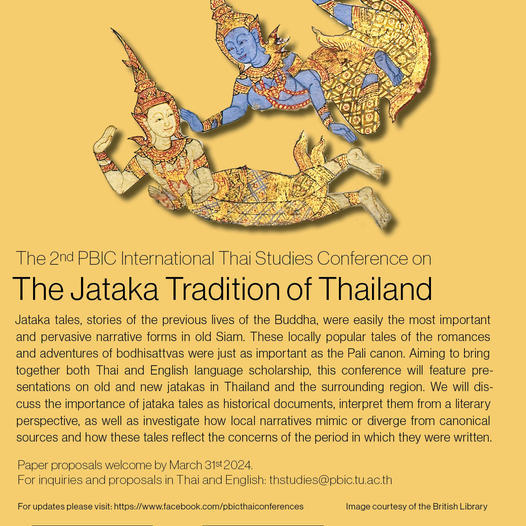
View On WordPress
0 notes
Text
Types of Traditional Thai Dance in Man Suang
We see two styles of traditional Thai dance-drama (Lakhon Ram) in Man Suang: Lakhon Nok and Lakhon Nai.
Lakhon Nok
The film opens with Khem performing the role of Sang Thong in what looks like a local event for a lord.

And we also see him in the iconic golden outfit for his performance as Phra Lor.
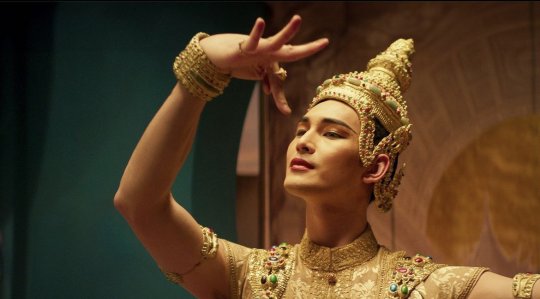
Lakhon Nok is traditionally a folk style dance drama performed by commoners.
The theatre took place away from royal palaces and was often performed at temple fairs.
Originally, Lakhon Nok was an all male dance style but these days women perform it too.
The stories are fast paced and the movements are typically more relaxed and not as refined as those you would find in Lakhon Nai or Khon, the two dance styles most associated with royal performance.
Costumes can be very simple or more elaborate.
The stories are often based on Buddhist Jataka tales and folklore with fantastical creatures like ogres, mermaids and spirits in abundance.
Traditionally any kind of story could be told except The Ramakien, Inao and Unnarut, which were reserved for royal performances of Lakhon Nai or Khon.
Popular examples of Lakhon Nok include:
Sang Thong
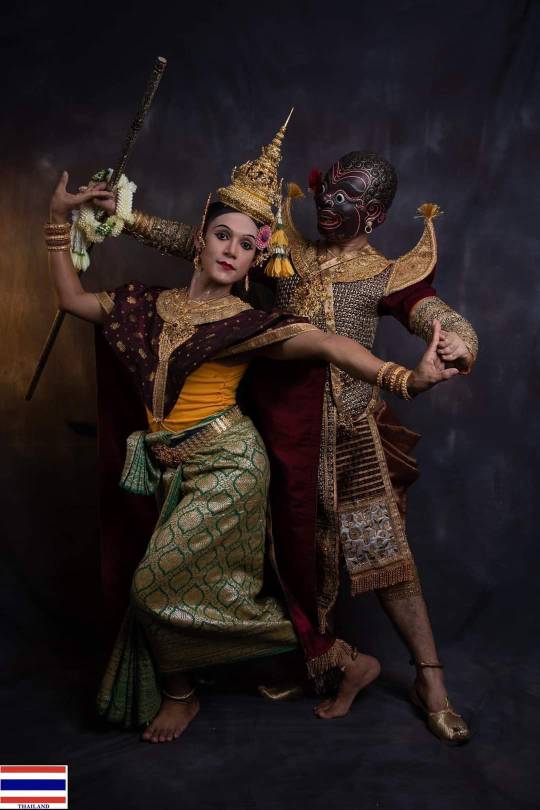
Phra Lor/Law
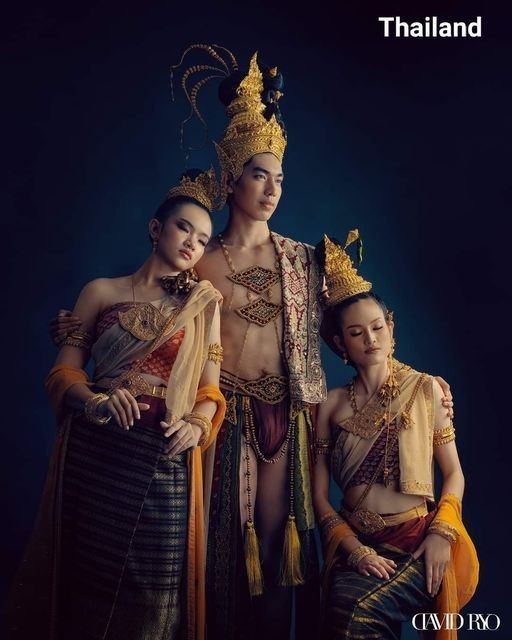
Phra Aphai Mani

Lakhon Nai
Wichiendej asks to see Khem as Inao, the hero of the Lakhon Nai dance drama.

Lakhon Nai was originally performed exclusively for the royal court by an all female group.
We do overhear Mae Kru Phikul arguing about this in the background of one scene. Shortly after this time period men would be allowed to perform in Lakhon Nai as well but I imagine it was still quite a transgressive act in this tumultuous time frame.
Only the king and members of his court were allowed to watch but during this time period, Rama 3 turned against royal dance as an art form and ordered a stop to both Lakhon Nai and Khon performances. This is likely the reason that Mae Kru Phikul ends up at Man Suang.
Characteristics of Lakhon Nai include extremely refined dance movements, adhering to traditional Thai aesthetic principles.
This is why we see Khem going to such drastic measures in his training montage, because he would be required to dance to a much more technical higher standard than he would have had to do when performing Lakhon Nok plays.
Costumes are elaborate and exquisite as befits a royal court.
The plots of Lakhon Nai come from three stories:
The Ramakien (a Thai version of the Ramayana)
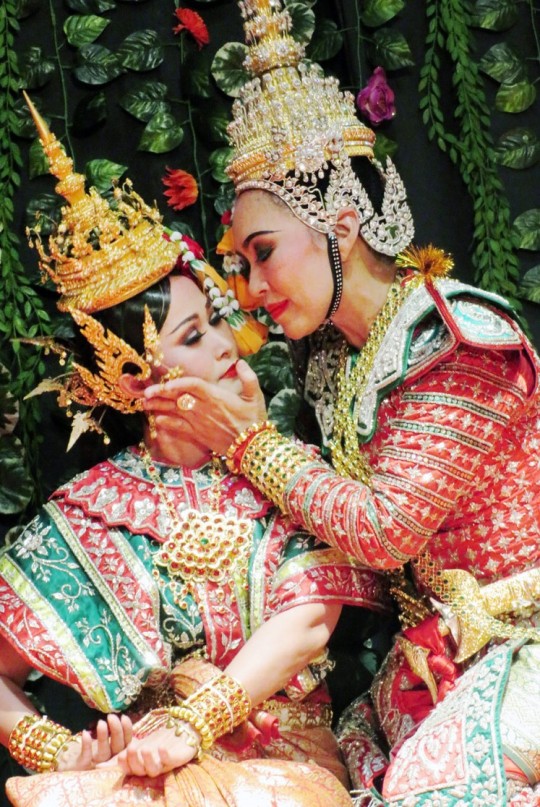
Inao (The prince of the Panji tales.)

Unnarut (stories of the son of Krishna.)
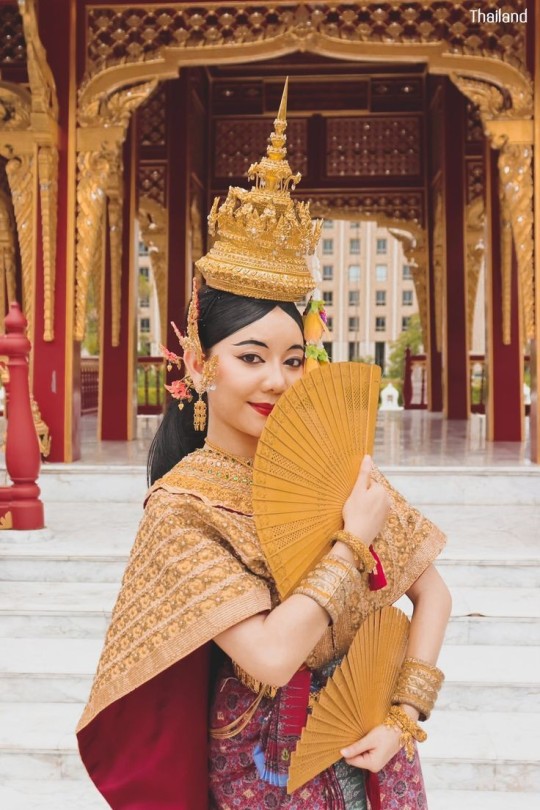
There are other types of Lakhon dance styles but these are the two that are showcased in Man Suang.
I was a little surprised we didn't see Khon, the famous masked dance drama style of Thailand but it was another dance form originally exclusive to royal courts so I can also understand why it didn't show up in the film.
#man suang fic inspiration#man suang meta#mansuang#man suang#thai dance#traditional dance#lakhon nai#lakhon nok#lakhon ram
171 notes
·
View notes
Text

10 - Kinnara and Kinnari
Kinnara, and the female kinnari, are creatures from Hindu and Buddhist mythology. Believed to come from the Himalayas, they often watch over the well-being of humans in times of trouble or danger. They are described as part human and part bird, and have a strong association with music and love. They are featured in a number of Buddhist texts, including the Jataka tales and Lotus Sutra.
Their character is also clarified in the Adi Parva of the Mahabharata, where they say:
We are everlasting lover and beloved. We never separate. We are eternally husband and wife; never do we become mother and father. No offspring is seen in our lap. We are lover and beloved ever-embracing. In between us we do not permit any third creature demanding affection. Our life is a life of perpetual pleasures.
#inktober2023#my works#inktober#there's a LOT of version of these guys so please forgive any generalizations from the wiki#also heavily considered remaking this one because i wasn't happy with how it turned out#had to redo the entire background#but i don't have the time
31 notes
·
View notes
Text
Rasetsunyo/Deer
Youkais— the Buddhist priests would sermonise, were inherently heretical. Their base nature compelled them to give in to their animal instinct instead of following the path to enlightenment.
Rastesunyo would disagree, but her lord husband, the current crown prince, was pacing their bedroom, cursing humans to the heavens. He had been forced to approve the arrest and execution of his friend, who’d been eating humans. To the Great Bull Demon, it was no different than eating a pig or a vegetable. Furthermore, to the prince, cannibalising another youkai for power was not truly condemnable. At her protests of his tirade, he snaps at her before rushing to his favourite concubine. It has become a competition; if she did not fall pregnant faster than the damned raccoon, she would lose her status.
She slips away from the castle into the depths of the pine forests surrounding it. She shudders, slipping into her animal coat, her form a deer with nine different colours marking her pelt. She glides through the forest, her wind helping her travel great distances fast until she reaches one of the purest lakes in the mountains. She rests next to the lake.
Youkais— the Buddhist priests would sermonise, were inherently heretical. Their base nature compelled them to give in to their animal instinct instead of following the path to enlightenment.
Rastesunyo would agree. Except her actions weren’t heretical but an expression of her true self.
Suddenly, the wind brings her the frightened screams of a human. She follows the noise to see a man drowning in a river. She pulls him out.
“You — saved me, thank you.”
She tells the man it is of no concern, tail flicking, before requesting that he keep her a secret.
He agrees, and she lets him go.
Several months later, she has another disagreement with her lord husband. He rushes away again, leaving behind his legal wife and firstborn for his concubine. She sighs before paying attention to her infant son. He had been hiding in the wardrobe.
“Come with me.” She commands.
She carries her boy on her back, leaping through the woods. The boy delights at the rush of the wind through his bright red hair, small hands grasping her antlers. The lake is as pristine as ever, reflecting the brilliant blue sky.
She hears a sudden rustle.
THWANG.
The arrow strikes her haunches, pain clouding her senses. She turns. The man is there with an army of humans.
“Forgive me.” He beseeches, surrounded by hunters with weapons.
Youkais— the Buddhist priests would sermonise, were inherently heretical. Their base nature compelled them to give in to their animal instinct instead of following the path to enlightenment.
This time Rasetsunyo gives into hers.
-------
Written for @monthlyminekura Christmas Edition. Day 7: Deer
A/N: Based on the Buddhist Jataka Tale of the nine-coloured deer.
A/N: In the original Journey to the West the youkai/demons are often heavenly gods/creatures that have left heaven. My guess is the same actually holds true in Saiyuki as well.
9 notes
·
View notes
Text
amar chitra katha comics, the only reason why i know so much about indian mythology and panchtantra and jataka tales
#i have like a whole collection of them#shubh and i'd devour them everyday#they're one of my favourite rereads till date#ack my beloved#thank you for the knowledge#amar chitra katha#ack comics#desiblr#desi tag#desi memes#desi shit posting#growing up desi#desi tumblr#desi culture#desi#just desi things#shanti ki ashanti suno
111 notes
·
View notes
Text
this is more of a literary observation, but reading the ‘secular’ (by which I mean non explicitly religious traditional canon) texts in Sanskrit is often very revealing. I was reading the Kathasaritsagara almost entirely for fun; I’m obsessed w/ frametales, story collections like the 1001 nights & the Decameron etc and it’s one of the oldest and largest. Lotta great tales in it, very rich, also lots of nonsense, also a tremendous mess: it’s great even if I think there are no great translations of it
but one of the books shocked me. The author of the text is a Kashmiri Shaivite, and the general frametales is about Shiva and Parvati (and most of the openining invocations are about them or Ganesha, occasionally Vishnu or Krishna but rarely). And an entire book is just about Buddhism! Obviously Jataka tales and the origin story, but it also contains ‘multicultural’ *arguments* and defenses for Buddhism—-none of which are the ‘Vishnu as avatar’ story. It’s seperate, but needs to be respected: and obviously the text is assuming an upper caste Brahminical reader, so supposedly this is supposed to be a lesson for them
11 notes
·
View notes
Photo

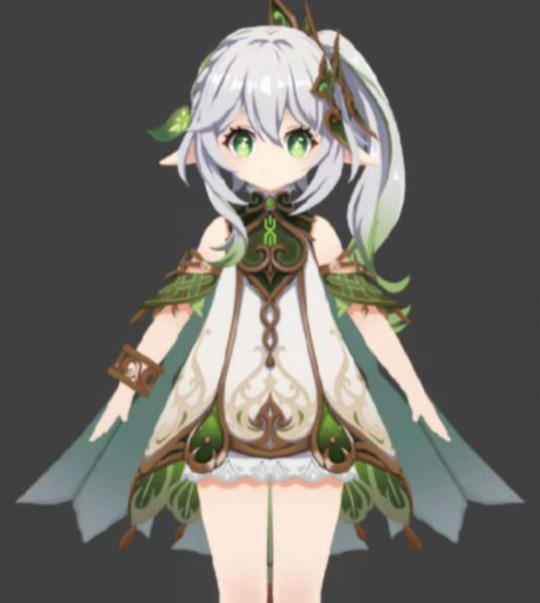
After the horrendous design of the dendro archon was leaked, it was only a matter of time until I took things into my own hands and redesigned her. Left is my design, right is whatever monstrosity mihoyo made.
I decided to go ahead and not make her an adult, because so many amazing artists have already done that for her. Instead I wanted to keep her the same age while making a design that's not. Western fairy child.
If you take offence at the fact that I redesigned her or am “disrespecting” the original, See Yourself Out.
Design notes under the cut because I have a mini essay here
Kusanali’s name (via leakers), “Nahida'' is likely derived from “Nahid”, a derivative from the Zoroastrian goddess Anahita. However, the title “Kusanali” itself is of buddhist origin, from the Jataka Tales specifically. Keeping both these names in mind, I wanted to make a design that referenced both Anahita and the Buddhist influence on Nahida.
The first step was figuring out how much influence buddhism had on the persian empire and it was.. not a lot. Only the eastern part of the empire was influenced to some small degree. I then narrowed down the time of spread to when the Parthian empire was a major power.
With an empire spreading all the way from modern day Iran to Pakistan, it should be obvious that the cultures it covered are all not the same, and this isn’t even getting into how diverse the ethinic groups are. We do not randomly mash the most “aesthetic” cultures together here sir.
I was using the buddhist hotspot city of Gandhara (marked roughly with the white X) as a point of reference for where to take design inspiration from.

Since Parthia was too far north from Gandhara, it would have been less influenced by buddhism. A friend stepped in and helped narrow down prominent regions that Parthia was allied with, and they finally located the one that was closest to Gandhara (circled in white).

The Sistan and Baluchistan region is populated by the Baloch people of Afghanistan + Pakistan, with clothes having a very distinct embroidery style. I referenced the basic silhouette of the clothes and jewelry from them but took some liberties with the embroidery itself.
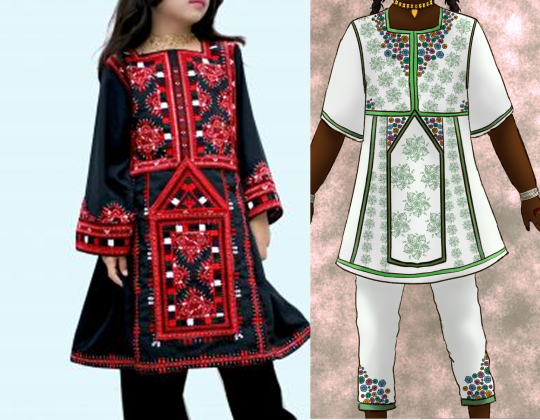
The pattern I made for the dress was made using a peepal/bodhi leaf as base. The bodhi tree is symbolic of Buddha’s enlightenment. You can also see the leaf’s shape in her necklace and headpiece as well.
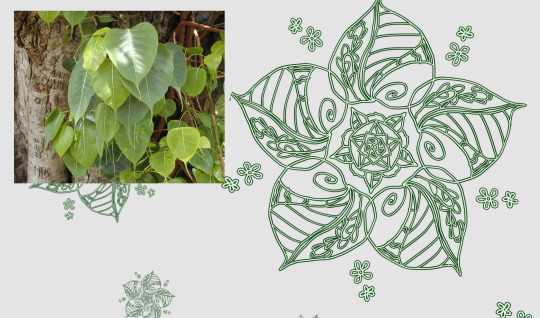

The other buddhist elements I used were how sculptors drew the lotus the buddha sits on with her slippers, and her earrings. To my knowledge, plain hoops are not a commonly used style, but I wanted to draw parallels to how the buddha’s ears are shaped in sculptures.
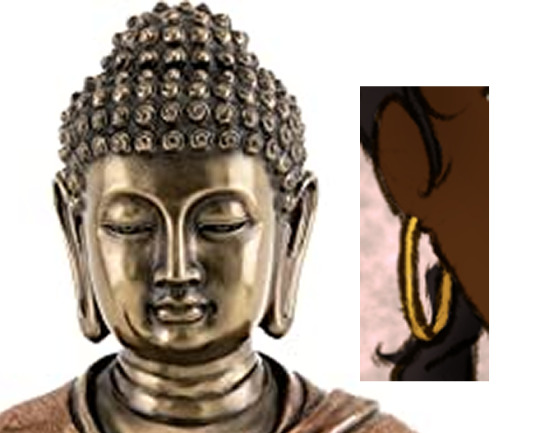
Anahita’s influence is more apparent in my colour choices. This extract describes how she looks;
She is regularly depicted as a beautiful woman in a white gown embroidered with gold, wearing golden earrings with a gold necklace around her throat and a golden crown. She carries the barsom twigs of life in one hand (representing the bounty of the earth and, so, fertility) and drives a chariot drawn by four horses of wind, rain, cloud, and sleet.
Hence the gold jewelery and white base clothes. No this is not a Saraswati reference because the two goddesses are Not The Same.
Finally her henna, when I looked up barsom, I found this Zoroastrian ritual tool by the same name that holds the barsom/barsam/myrrh twigs. I referenced the crescent shape of the tool in Nahida’s henna, and looked at other henna designs in order to create it.

#genshin impact#genshin impact sumeru#sumeru#genshin Kusanali#oc: Nahida#yes this is my child now#genshin
102 notes
·
View notes
Text

Wait till they (bigoted conservative right wing white supremacists) realize the Cinderella, Snow White, many fairy tales and folk tales ALL have origins from MANY places that aren't from Europe/originated from stories from pre-European & peasant folk/are recurring tropes and narratives from across the globe (sorry there was a typo here😔 but i meant to say check the Motif Index on Folk Literature and the study of folklore, it's a branch of anthropology, and studies literature and oral traditions that are shared by humanity across ages!)
and they're simply clamoring for the white washed versions because they don't know how to step out of their bubble
The One Thousand and One Nights, and various versions of Cinderella are said to have Persian/Arab and Chinese roots! And there's even a Cinderella story in ancient Egypt!
And from just looking up fairy tale as a term, ancient India has the Jataka, a collection of stories about Buddha reincarnated as different people, and this is described as one of the best surviving fairytale compilations
And regarding the Shanameh, the heroine Rudaba is described with long raven hair and such. But I won't spoil it: here's the Iran online site where Shanameh fairy tale is:
https://www.iranicaonline.org/articles/rudaba
Another online site, with lots of Islam literature, where Rudāba's story is:
#fairytale#black mermaid#little mermaid#poc#cinderella#rapunzel#persian#fuck bigots#fuck whitewashing#whitewashing#islam literature#literature#folklore#folktales
3 notes
·
View notes
Text

The story of Gautama Buddha, known as Shakyamuni, in his past life as Sumedha, a wealthy man turned hermit, is significant in Buddhist art and teachings. Sumedha demonstrated his devotion by laying his hair on the ground for the Dipankara Buddha to walk over, avoiding a muddy puddle. This act of piety led Dipankara Buddha to predict that Sumedha would become a Buddha named Shakyamuni in the future.
Dipankara Buddha also foretold that Shakyamuni would be a great teacher born into the Shakya clan, the son of King Suddhodana and Queen Maya, with Shariputta and Moggallana as his chief disciples and Ananda as his caretaker. This encounter marked the beginning of Shakyamuni Buddha's journey towards enlightenment, during which he would recount many past life stories, known as Jataka tales. This story, among others, illustrates the importance of the 10 Paramitas or
"perfections" on the path to becoming a Buddha.
Shakyamuni Buddha's first significant step towards enlightenment, receiving a prediction of his future Buddhahood from Dipankara Buddha, is captured in the Mahayana text, the Sangatha Sutra.
2 notes
·
View notes
Text
Happy new year 2023 from Tonari!

Year of the Rabbit is upon us in 2023 and I'm just gonna drop some fun meta in accordance to this image.
Because I can.
Can't forget that Saitama did some bugs bunny stuff before.
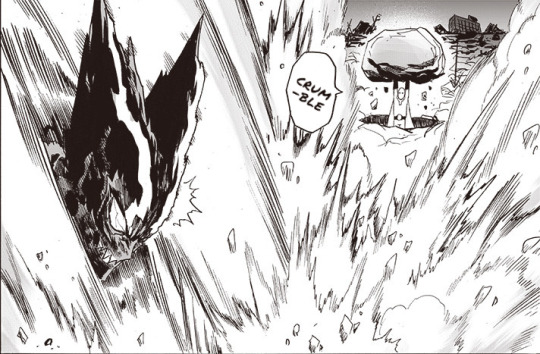
What he did on Moon of I.O is basically bending reality like he's a cartoon character. So it kinda fits with the rabbit and the moon mythos lol.
But I'm also interested about all the symbolism of the rabbit and the moon and the chinese zodiac.
In the Buddhist Jataka tales,[4] Tale 316 relates that a monkey, an otter, a jackal, and a rabbit resolved to practice charity on the day of the full moon (Uposatha), believing a demonstration of great virtue would earn a great reward. When an old man begged for food from them, the monkey gathered fruits from the trees and the otter collected fish, while the jackal found a lizard and a pot of milk-curd. Knowing only how to gather grass, the rabbit instead offered its own body by throwing itself into a fire the man had prepared. However, the rabbit was not burnt and the old man revealed that he was Śakra. Touched by the rabbit's virtue, he drew the likeness of the rabbit on the Moon for all to see. It is said the lunar image is still draped in the smoke that rose when the rabbit cast itself into the fire. The rabbit is believed to be a Bodhisattva.
Han Dynasty poets call the hare on the Moon the "Jade Hare" (玉兔) or the "Gold Hare" (金兔), and these phrases were used often, in place of the word for the Moon. A famous poet of Tang China, Li Bai, relates how "The rabbit in the moon pounds the medicine in vain" in his poem, "The Old Dust".
When Westerners gaze at the 月亮 (yuèliang; moon), they may jokingly say that the moon is made out of cheese or that they see the Man in the Moon. When a Chinese person looks at the moon, however, they most certainly will see the Jade Rabbit (玉兔 Yùtù) standing under a cassia tree holding a precious elixir.
Like the Chinese zodiac itself, the legend of the Jade Rabbit has many different origin stories. One of the most common stories in China begins with the Jade Emperor disguising himself as a beggar. Once disguised, he embarks on a journey to find a worthy animal to help him prepare the elixir of life.
In this tale, the Rabbit willingly attempts to sacrifice himself as food for the beggar by jumping into a fire. However, the Rabbit is saved by the Jade Emperor, who then carries the Rabbit to the moon where he helps create the elixir of life.
Those looking for the Jade Rabbit will find his outline on the moon with his pestle and mortar, mixing the divine elixir to this day.
The concept of the Chinese zodiac has spread to other Asian countries, but other cultures have slightly different interpretations regarding the Jade Rabbit. In Japan, the Old Man of the Moon brings the Rabbit back to the moon to live with him because of the Rabbit’s great kindness.
According to this myth, the image seen on the surface of the moon is of a rabbit pounding out mochi rice cakes, not the elixir of life.
About this elixir of life...I've thought about references to elixir of immortality before.
The elixir of life, also known as elixir of immortality, is a potion that supposedly grants the drinker eternal life and/or eternal youth. This elixir was also said to cure all diseases. Alchemists in various ages and cultures sought the means of formulating the elixir.
In the 8th century AD Man'yōshū, 'waters of rejuvenation' (変若水, ochimizu) are said to be in the possession of the moon god Tsukuyomi. Similarities have been noted with a folktale from the Ryukyu Islands, in which the moon god decides to give man the water of life (Miyako: sïlimizï), and serpents the water of death (sïnimizï). However, the person entrusted with carrying the pails down to Earth gets tired and takes a break, and a serpent bathes in the water of life, rendering it unusable. This is said to be why serpents can rejuvenate themselves each year by shedding their skin while men are doomed to die.
I am distinctly reminded of the part where Sage centipede's carcass drops down on top of heroes while it bathes in ocean water. Heroes were definitely kind of doomed to just perish here, but Saitama parking a large ship avoided the disaster. Then pig god casually eating all the heroes allowed them to ultimately survive. Sage centipede and Elder centipede were notorious for being practically immortal because they just regenerated and shed their skin, so Garou had to destroy it's heart.
Ergo, removing the heart removes the source of lifeblood, so might be one to keep in mind.
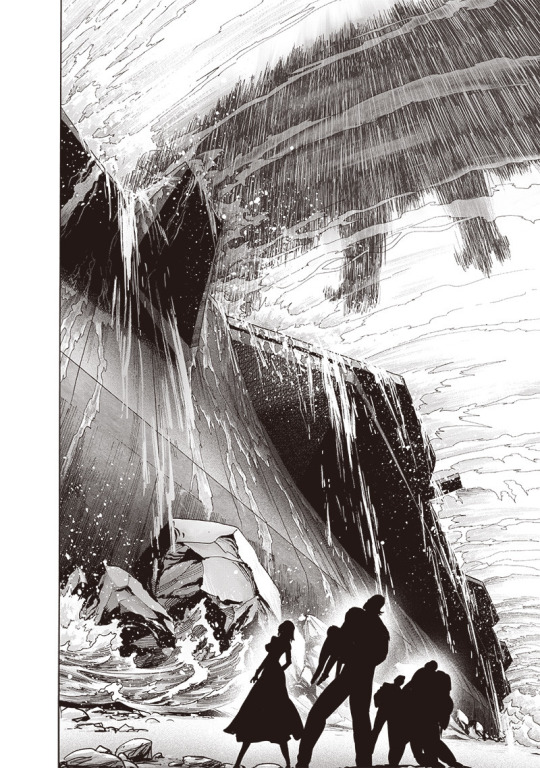
I can't forget how Pig god ate Evil Natural Water and how human body consists of mostly water and what it might entail cuz he ate evil natural water remnants.
Can't forget how Psykos also made Evil Natural Water and she has serpent motifs.
So if divine power is "elixir of immortality" and evil natural water is a construct of what may be just divine power, water and evil intent...checks out.
Oh and OPM God being in possession of elixir of life? Lifeblood? Yeah. Also checks out because the one below is depicted with little more than blood circulatory system.

Makes you wonder why a samurai dude, I forget the name, who got cleaved in half somehow didn't die. And tank top master got brutally mangled and somehow...survived and is not worse for the wear. And Air got his neck pierced and his spine and idk, he's gonna be ok too right?
Divine power = elixir of life sounds appropriate.
Rabbit personality traits
Let’s start with the impact of being born in the Year of the Rabbit on personality.
Rabbit people are said to live life free from constraints and are in constant pursuit of their ideas. Because of their weak wills, however, they have difficulty achieving great things.
In addition, Rabbits are sometimes too guarded and delicate when managing human affairs and personal matters. While they tend to be tenacious and ambitious, these characteristics may also lead to jealousy when they don’t get their way.
Those born under the sign of the rabbit do not like to argue, preferring peace and quiet. They are good listeners, excellent negotiators and tend to work well on a team.
They can be artistic and creative but also have a strong desire to avoid stressful and risky situations. They can also be pessimistic and insecure and therefore are hesitant to make quick changes.
Sounds like an interesting year might be ahead of Saitama.
And finally, an aztec mythos reference, because OPM God's temple is basically an aztec temple.
According to an Aztec legend, the god Quetzalcoatl, then living on Earth as a human, started on a journey and, after walking for a long time, became hungry and tired. With no food or water around, he thought he would die. Then a rabbit grazing nearby offered herself as food to save his life. Quetzalcoatl, moved by the rabbit's noble offering, elevated her to the Moon, then lowered her back to Earth and told her, "You may be just a rabbit, but everyone will remember you; there is your image in light, for all people and for all times."
"Quetzalcoatl, in its literal sense, means 'serpent of precious feathers', but in the allegorical sense, 'wisest of men'."[6]
Among the Aztecs, whose beliefs are the best-documented in the historical sources, Quetzalcoatl was related to gods of the wind, of the planet Venus, of the dawn, of merchants and of arts, crafts and knowledge. He was also the patron god of the Aztec priesthood, of learning and knowledge.
Quetzalcoatl, the Aztec god of the sun and wind, air, and learning, wears around his neck the "wind breastplate" ehēcacōzcatl, "the spirally voluted wind jewel" made of a conch shell. This talisman was a conch shell cut at the cross-section and was likely worn as a necklace by religious rulers, as such objects have been discovered in burials in archaeological sites throughout Mesoamerica,[8] and potentially symbolized patterns witnessed in hurricanes, dust devils, seashells, and whirlpools, which were elemental forces that had significance in Aztec mythology.

I mean yea, Feathered Serpent basically. Quetzalcoatl reference. And Psykos learned more than she wished for and according to her, became the ultimate being of intelligence.
A very interesting year ahead.
Unlike Tigers though, like last year, Rabbits are prey animals. And many myths talk about Rabbits making some kind of sacrifice and how appropriately we're also dealing with a dude from Tsukuyomi at the same time. Like oh em gee rabbit and the moon mythos oh em gee.
#opm#one punch man#new year#opm meta#saitama#year of the rabbit#psykos#psykorochi#chinese zodiac#aztec#Quetzalcoatl#mythology#elixir of life
37 notes
·
View notes
Text
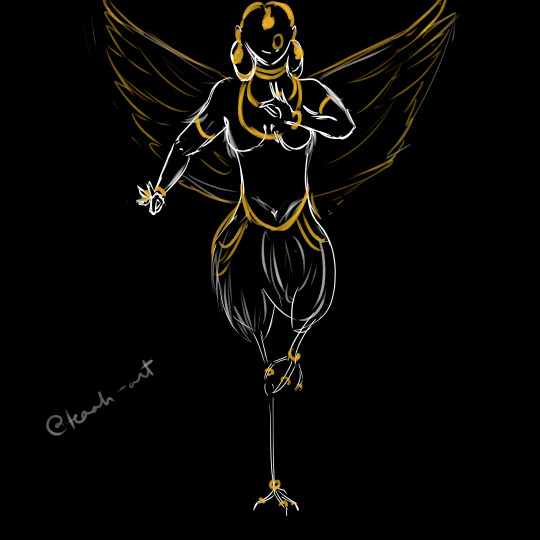
Inktober Day 16 : Angel
Medium : G Pen, Digital
The South Asian 'Angel' equivalent is Pari and we borrowed that from Central Asia (Peri in Persian) during medieval times. So the closest thing to a winged heavenly being in Ragtag Misfits instead is a Kinnar!! NOT A PARI!! Kinnar are animal-human hybrid creatures — half bird and half human according to Buddhist Jataka tales and sometimes even half bird half horse half human according to Hindu texts. I have SO MUCH to talk about when it comes to them, maybe await a different post. For now, know that they live in Suvarnabhumi and will show up in the final arc.
Gonna use Inktober this year to do some Ragtag Misfits character/story exploration!
Read Ragtag Misfits Here
#ragtag misfits#rgtg#webtoon#inktober 2023#inktober challenge#inktober prompts#kinnara#kinnar#original art#my art
4 notes
·
View notes
Photo

Buddha Shakyamuni and Scenes of His Previous Lives (Jataka Tales). 1573–1619. Credit line: Zimmerman Family Collection, Purchase, Lila Acheson Wallace Gift, 2012 https://www.metmuseum.org/art/collection/search/78196
#aesthetic#art#abstract art#art museum#art history#The Metropolitan Museum of Art#museum#museum photography#museum aesthetic#dark academia
4 notes
·
View notes
Text
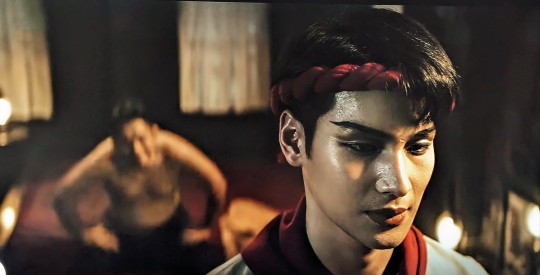
I've been thinking (overthinking) about this costume of Khem's
It could be that he is portraying some heroic figure from one of the many jataka tales. A commoner perhaps.
But I also think, from what little we can see of it, (which is a crime,) that it has some elements that really remind me Lanna folk dances. Specifically the dance that comes from Jerng, the ancient Northern Thai martial art form.
There are two types of this dance:
Forn Jerng (barehanded)


Forn Jerng Daab (sword dance.) sometimes you will see flags in place of swords.




The headband and the rope around the arms is what gives me that impression but I'm just guessing here as we see no glimpse of the dance itself and barely anything of the costume.
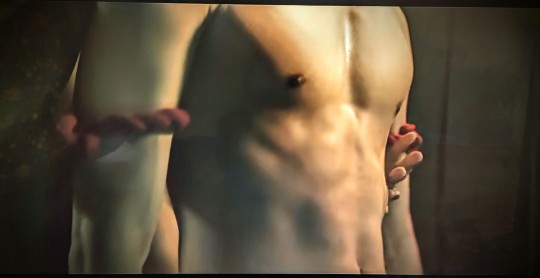
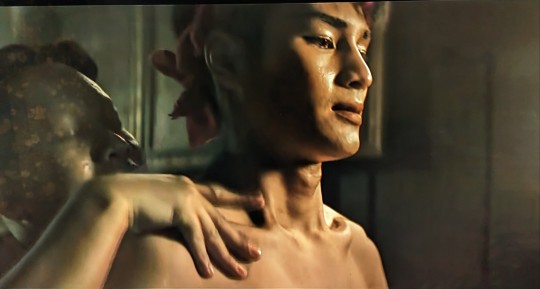
#man suang#mansuang#man suang meta#khem#apo nattawin#thai dance#thai film#his eyes look so dead here#my baby#heartbreaking 💔#somebody save him#that man needs a knife to the throat#man suang spoilers
53 notes
·
View notes